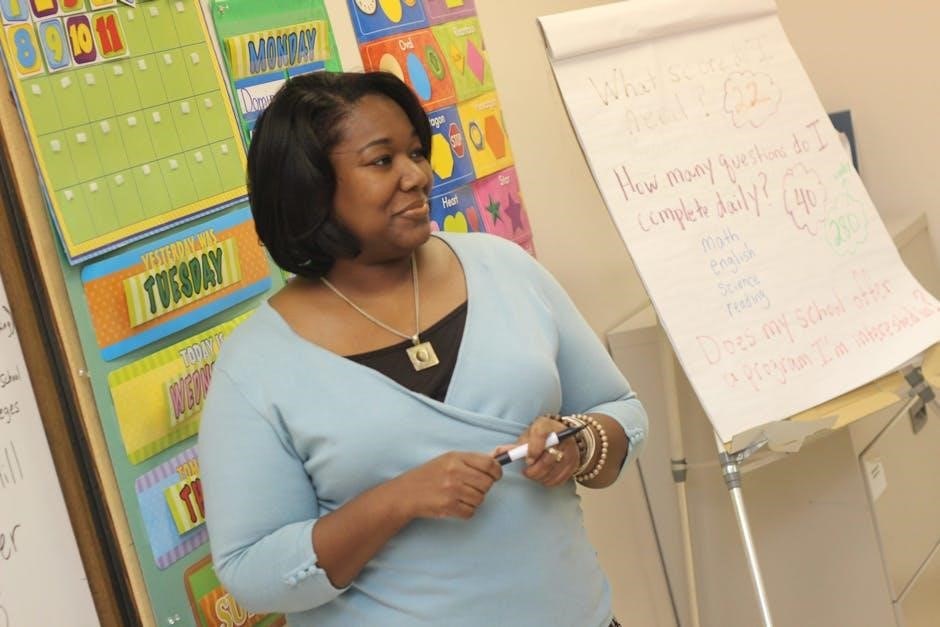Lesson Plans for 1-2 Year Olds PDF: A Comprehensive Guide
Discover engaging and educational lesson plans tailored for toddlers aged 1-2 years. These PDF guides offer structured activities, themes, and creative exercises to foster early childhood development.
Each plan includes sensory play, music, and storytelling, promoting fine motor skills, language, and social-emotional growth. Perfect for daycare providers and parents seeking organized, flexible routines.
Download customizable templates and access weekly schedules with fun, age-appropriate tasks. These resources ensure a stimulating and nurturing environment for young learners to thrive creatively and academically.
Toddler lesson plans are carefully designed to cater to the unique needs of children aged 1-2 years, focusing on play-based learning and developmental milestones. These plans emphasize structured yet flexible activities, fostering creativity, curiosity, and foundational skills. By incorporating sensory play, music, and storytelling, they create engaging experiences that promote cognitive, motor, and social-emotional growth. Lesson plans for this age group are adaptable to various settings, such as daycare centers or home environments, ensuring consistency and continuity in early childhood education. They also provide educators and caregivers with practical tools to support young learners in a nurturing and stimulating way, laying the groundwork for future academic success.
Importance of Structured Activities for 1-2 Year Olds
Importance of Structured Activities for 1-2 Year Olds
Structured activities play a vital role in the development of 1-2 year olds, providing a sense of routine and stability. These activities help toddlers develop essential skills such as problem-solving, coordination, and communication. They also foster independence, self-confidence, and social interaction. By engaging in planned tasks, young children learn to follow directions, complete tasks, and manage transitions smoothly. Structured play further enhances their ability to focus and concentrate, laying a strong foundation for future academic and personal success. Incorporating these activities into daily routines ensures a balanced and enriching environment for toddlers to grow and thrive.
Benefits of Using PDF Formats for Lesson Plans
Benefits of Using PDF Formats for Lesson Plans
Using PDF formats for lesson plans offers numerous advantages, particularly for educators and caregivers. PDFs are easily accessible and can be viewed on various devices, making them highly convenient. They maintain a consistent layout and formatting, ensuring that lesson plans are presented clearly. PDFs are also simple to share and print, allowing for seamless collaboration among teachers and parents. Additionally, PDF lesson plans can be customized while retaining professional quality, making them adaptable to different learning environments; This format is ideal for creating structured, visually appealing plans that support engaging and effective teaching practices for young children.

Key Components of Lesson Plans for 1-2 Year Olds
Key components include structured activities, theme-based learning, sensory play, and age-appropriate tasks designed to promote developmental milestones in toddlers.
Theme-Based Learning: Examples and Ideas
Theme-Based Learning: Examples and Ideas
Theme-based learning engages toddlers by focusing on relatable topics like “My Body,” “Farm Friends,” or “Seasonal Fun.” These themes organize activities around a central idea, fostering curiosity and structure.
- Farm Theme: Explore animal sounds, tractor rides, and harvest-themed crafts to promote sensory and imaginative play.
- Body Parts: Use songs, mirrors, and art to teach anatomy, encouraging self-awareness and fine motor skills.
- Seasonal Activities: Incorporate holidays or weather, like Halloween costumes or snowflake crafts, to connect learning with real-world experiences.
These themes provide a cohesive framework for lesson plans, making learning fun and meaningful for young children while allowing flexibility for adaptation and parental involvement.
Sensory Play Activities for Toddlers
Sensory play is a cornerstone of toddler development, fostering exploration and learning through touch, sight, and sound. Activities like playdough molding, water table experiments, and texture bins filled with rice or sand are perfect for this age group.
- Playdough Creations: Enhances fine motor skills and creativity while introducing colors and textures.
- Sensory Bins: Offers tactile experiences, encouraging curiosity and dexterity with materials like beads or pasta.
- Water Play: Develops hand-eye coordination and scientific awareness through pouring and measuring activities.
These activities not only stimulate sensory development but also build foundational skills like problem-solving and creativity. Supervision is key to ensure safety and maximize learning potential.
Music and Movement Exercises
Music and movement activities are essential for toddlers, promoting physical coordination and creative expression. Simple songs with actions, like clapping or marching, engage young children and introduce rhythm and timing.
- Action Songs: Encourage toddlers to follow directions and imitate movements, fostering cognitive development and motor skills.
- Dance Games: Use scarves, ribbons, or bubbles to create interactive fun, enhancing coordination and creativity.
- Instrument Play: Introduce simple instruments like tambourines or drums to explore sound and rhythm.
These exercises not only aid in physical development but also foster self-expression and social interaction, making them a vital part of lesson plans for 1-2 year olds;
Storytelling and Reading Aloud
Storytelling and reading aloud are powerful tools for fostering language skills and imagination in toddlers. Choose simple, colorful books with engaging textures and repetitive phrases to capture their attention.
- Interactive Reading: Encourage pointing to pictures and naming objects, which enhances vocabulary and comprehension.
- Rhyming Stories: Introduce nursery rhymes and rhythmic texts to develop phonological awareness and a love for language.
- Story Sequencing: Use puppets or props to act out stories, promoting creativity and memory skills.
Reading aloud daily helps toddlers develop listening skills, builds curiosity, and lays the foundation for future literacy. Make storytelling a joyful, interactive experience tailored to their age and interests.

Daily Schedule and Activity Planning
Structured schedules with playtime, meals, and naps ensure consistency for toddlers. Flexible plans adapt to their needs, promoting exploration and development through balanced activities and rest periods daily.
Sample Weekly Lesson Plan for Toddlers
Sample Weekly Lesson Plan for Toddlers
A sample weekly lesson plan for 1-2 year olds might include themed days like “My Body” or “Farm Friends.” Each day features activities such as sensory play, music, and storytelling.
Monday: Explore body parts with songs and art. Wednesday: Discover farm animals through stories and animal sounds.
Friday: Engage in outdoor play with nature walks and counting games.
These plans are designed to promote curiosity and development while allowing flexibility for individual needs.
PDF templates offer organized schedules and activity ideas, making it easy to adapt and share with parents or caregivers.
This structured yet flexible approach ensures toddlers thrive in a nurturing environment.
How to Create a Flexible Daily Routine
How to Create a Flexible Daily Routine
Creating a flexible daily routine for 1-2 year olds involves balancing structure with adaptability. Start with a loose framework that includes regular times for sleep, meals, and play.
Incorporate short, engaging activities like sensory play or storytelling, allowing for transitions and free time. Be prepared to adjust based on the child’s mood or unexpected events.
Use visual schedules or cues to help toddlers anticipate what’s next. Prioritize outdoor play and physical movement to promote energy release and exploration.
Ensure the routine includes moments for rest and relaxation, such as reading or quiet play. Flexibility is key to meeting individual needs while maintaining a sense of predictability.
This approach fosters a nurturing environment that supports development and adapts to the child’s ever-changing interests and energy levels.
Incorporating Outdoor Play
Incorporating Outdoor Play
Incorporating outdoor play into lesson plans for 1-2 year olds is essential for their physical and cognitive development. Activities like exploring nature, ball games, and sensory walks stimulate curiosity and motor skills.
Organized outdoor play, such as themed scavenger hunts or simple obstacle courses, encourages creativity and teamwork. Weather permitting, include regular visits to parks or gardens to introduce toddlers to diverse environments.
Outdoor play fosters independence, coordination, and an appreciation for nature. It also provides opportunities for social interaction, helping toddlers develop communication and cooperation abilities.
Ensure safety by supervising closely and adapting activities to suit the children’s energy levels and interests. Outdoor play is a vital component of a well-rounded daily routine for young learners.

Developmental Goals for 1-2 Year Olds
Developmental goals for toddlers include mastering motor skills, enhancing language, and fostering social-emotional growth through interactive activities and structured play, ensuring holistic development during early childhood.
Fine Motor Skills Development
Fine Motor Skills Development
Fine motor skills development is crucial for 1-2 year olds, focusing on hand-eye coordination and dexterity. Activities like drawing, stacking blocks, and using small tools enhance these abilities, preparing toddlers for tasks like dressing and feeding themselves. Playdough manipulation, finger painting, and puzzles also stimulate creativity and precision. Incorporating these exercises into lesson plans helps build foundational skills for future academic success. Consistent practice through engaging activities ensures steady progress, making fine motor development a key aspect of early childhood education.
Language and Communication Skills
Language and Communication Skills
Language and communication skills are essential for toddlers, fostering verbal expression and comprehension. Lesson plans incorporate activities like reading aloud, singing songs, and interactive conversations to encourage vocabulary growth. Storytime sessions with engaging books and rhymes help toddlers connect sounds and meanings. Simple role-playing and pretend play activities also enhance communication abilities. Additionally, labeling objects and encouraging toddlers to identify and name items during play supports language development. These structured exercises, included in PDF lesson plans, provide consistent opportunities for toddlers to practice and refine their communication skills, laying a strong foundation for future academic and social interactions.
Social-Emotional Learning
Social-emotional learning (SEL) is crucial for toddlers, focusing on self-awareness, empathy, and self-regulation. Lesson plans for 1-2 year olds often include activities that encourage sharing, cooperation, and understanding emotions. Simple games like “Simon Says” or group play help toddlers practice following directions and controlling impulses. Emotional awareness is fostered through stories and discussions about feelings, such as happiness, sadness, and anger. Activities like role-playing and puppet shows also promote social skills and empathy. By integrating SEL into daily routines, these PDF lesson plans help toddlers build strong interpersonal skills and emotional intelligence, preparing them for positive interactions and relationships.

Engaging Activities for Toddlers
Engage toddlers with fun activities like counting games, art projects, and science exploration. These tasks foster curiosity, creativity, and motor skills, making learning enjoyable and interactive for young minds.
Counting and Number Recognition
Counting and Number Recognition
Introduce toddlers to counting and number recognition through playful activities. Sing counting songs like “1, 2, 3 Little Polar Bears” and use props like ice cubes for interactive games.
- Engage in rhyming activities that emphasize numbers, such as “1-2 Buckle My Shoe.”
- Use visual aids and hands-on tasks to teach basic number concepts.
- Incorporate counting into daily routines, like sorting toys or counting steps.
These activities help develop problem-solving skills and lay the groundwork for future math abilities, making learning fun and engaging for young children.
Art and Craft Projects
Art and Craft Projects
Engage toddlers in creative art and craft projects to foster self-expression and fine motor skills. Simple activities like finger painting, crayon drawing, and collage making are ideal for this age group.
- Finger Painting: Explore colors and textures using washable paints and large paper sheets.
- Collage Making: Use safe scissors and glue for tearing and pasting colored paper shapes.
- Crayon Art: Provide large crayons for free drawing, encouraging creativity and hand-eye coordination.
These activities not only promote creativity but also align with developmental goals, making them a fun and educational part of toddler lesson plans. PDF guides offer easy-to-follow instructions for parents and educators to implement these crafts effectively.
Science and Exploration Activities
Science and Exploration Activities
Engage toddlers in simple, hands-on science activities to spark curiosity and early STEM skills. Activities like exploring natural objects, magnet play, and water experiments are perfect for this age group.
- Nature Walks: Collect leaves, rocks, and flowers for observation and sorting games.
- Magnet Exploration: Use safe magnets to discover attraction and repulsion with household items.
- Water Play: Experiment with pouring, measuring, and floating objects in water bins.
These activities encourage problem-solving, hand-eye coordination, and a love for discovery, aligning with developmental goals while being fun and engaging. PDF guides provide easy-to-follow instructions for parents and educators to implement these science-based lessons effectively.

Resources and Tools for Lesson Planning
Access free PDF templates, recommended books, and educational songs to enhance your toddler lesson plans. These tools provide structured yet flexible frameworks for engaging young learners effectively.
Free PDF Templates for Toddler Lesson Plans

Free PDF Templates for Toddler Lesson Plans
Utilize free PDF templates designed specifically for toddler lesson plans to create engaging and structured activities. These templates offer customizable frameworks for daily and weekly schedules.
They include space for themes, sensory play, music, and storytelling, making it easy to organize developmental goals like fine motor skills and language development. Perfect for daycare providers and parents.
Downloadable templates often feature sample activities, such as counting songs and labeling exercises, ensuring a nurturing environment for 1-2 year olds to thrive creatively and academically.
Recommended Books for Storytime
Recommended Books for Storytime
Engage toddlers with storytime using books like The Very Hungry Caterpillar and Goodnight Moon. These classics offer colorful illustrations and repetitive text, fostering language skills and imagination.
Interactive books such as Brown Bear, Brown Bear, What Do You See? encourage participation, while rhyming stories like The Wheels on the Bus promote phonological awareness and motor skills.
Choose books with simple, relatable themes like farms or family, aligning with lesson plan themes. Reading aloud enriches vocabulary and sparks curiosity, making storytime a cornerstone of early childhood education.
Educational Songs and Rhymes
Engage toddlers with educational songs and rhymes that promote learning through fun and repetition. Songs like The Wheels on the Bus and Old MacDonald Had a Farm introduce vocabulary and concepts like transportation and animals.
Rhymes such as Five Little Monkeys and If You’re Happy and You Know It encourage participation and motor skills. Action songs like The Hokey Pokey and Head, Shoulders, Knees, and Toes enhance coordination and self-awareness.
These activities foster phonological awareness, language development, and creativity. Incorporate clapping games and nursery rhymes into daily routines for a joyful and educational experience that supports early childhood development.

Safety and Safety Considerations

Safety and Safety Considerations
Ensure a safe learning environment by removing hazards, supervising activities, and using age-appropriate materials. Regularly inspect toys and spaces to prevent accidents and foster a secure space for exploration and play.
Creating a Safe Learning Environment
Creating a Safe Learning Environment
Creating a safe learning environment for 1-2 year olds involves careful planning and attention to detail. Start by removing any hazards, such as sharp objects or fragile items, from the play area. Ensure all furniture and equipment are stable and securely anchored to prevent tipping. Use soft, cushioned flooring to protect against falls and provide a comfortable space for movement. Store toys and materials in low, accessible shelves to encourage independence while maintaining supervision. Regularly inspect toys for small parts or choking hazards. Establish clear safety rules, such as staying within designated areas and gentle play. Supervise children at all times, especially during sensory or outdoor activities. This fosters a secure and nurturing space for toddlers to explore and learn.
Supervision Guidelines
Supervision Guidelines
Effective supervision is crucial for ensuring the safety and well-being of 1-2 year olds during lesson plans. Adults must maintain constant visual contact with children, especially during sensory play, outdoor activities, and transitions. Ensure the adult-to-child ratio is appropriate to provide individualized attention and immediate assistance when needed. Supervisors should be actively engaged, anticipating potential risks and intervening promptly to prevent accidents. Encourage children to stay within designated areas and model safe behaviors. Regularly check materials and toys for safety, and teach children to handle items gently. Supervision fosters a secure environment, allowing toddlers to explore confidently while minimizing hazards and promoting positive interactions.
Effective lesson plans for 1-2 year olds in PDF format provide structured, engaging activities that foster developmental growth. They incorporate sensory play, music, and storytelling, promoting motor skills, language, and creativity. Consistency and adaptability ensure a nurturing environment, while parental involvement enhances learning outcomes, making these plans a valuable tool for early childhood education.
Final Tips for Effective Lesson Planning
Final Tips for Effective Lesson Planning
When creating lesson plans for 1-2 year olds, prioritize flexibility to accommodate their natural curiosity and varying attention spans. Incorporate a variety of activities that cater to different learning styles, such as sensory play, music, and storytelling. Ensure activities are age-appropriate and safe, with materials tailored to their developmental stage. Encourage parental involvement by sharing daily highlights and involving them in activity planning. Rotate toys and materials regularly to maintain engagement and prevent boredom. Lastly, document progress to track developmental milestones and adjust plans accordingly, ensuring a personalized and effective learning experience for each child.
Encouraging Parental Involvement
Encouraging Parental Involvement
Encouraging parental involvement in lesson plans for 1-2 year olds fosters a collaborative learning environment. Share daily activity highlights with parents to keep them informed and engaged. Involve them in planning by asking for input on themes or activities their child enjoys. Provide resources, such as PDF templates, for parents to replicate activities at home. Encourage open communication through feedback forms or meetings to understand the child’s progress. By involving parents, you create consistency between home and school, reinforcing learning and strengthening the parent-child bond. This teamwork ensures a holistic approach to early childhood development, benefiting the child’s emotional, social, and cognitive growth.

Additional Resources
Explore more lesson plan ideas and join online communities for early childhood educators. Utilize free PDF templates and activity books to enhance your teaching resources effectively.
Where to Find More Lesson Plan Ideas
Where to Find More Lesson Plan Ideas
Discover a wealth of lesson plan ideas for 1-2 year olds through online platforms like Pinterest, Teachers Pay Teachers, and educational blogs; These resources offer customizable templates, themed activities, and engaging exercises tailored for toddlers. Additionally, join early childhood education communities on Facebook and forums to connect with fellow educators and parents. Many websites provide free downloadable PDFs with structured daily schedules and creative projects. Explore these platforms to find inspiration and practical tools for designing effective and fun lesson plans that cater to the developmental needs of young children, ensuring their growth and engagement in a nurturing environment.
Online Communities for Early Childhood Educators
Online Communities for Early Childhood Educators
Join online communities like Pinterest, Facebook groups, and early childhood forums to connect with educators and parents. These platforms offer a wealth of lesson plan ideas, templates, and activities for 1-2 year olds. Share resources, exchange tips, and gain inspiration from experienced professionals. Many communities provide access to free PDF lesson plans and customizable templates. Engage in discussions, ask questions, and collaborate on creating engaging activities for toddlers. These online spaces foster a supportive environment for educators to grow and share knowledge, ensuring high-quality learning experiences for young children. They are invaluable for staying updated on best practices and innovative teaching methods.